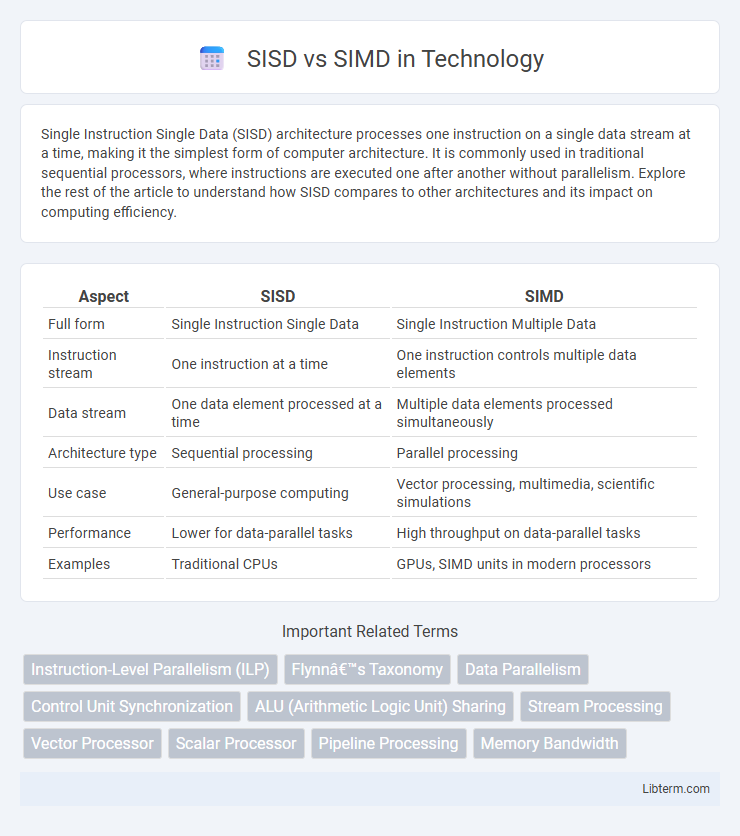Single Instruction Single Data (SISD) architecture processes one instruction on a single data stream at a time, making it the simplest form of computer architecture. It is commonly used in traditional sequential processors, where instructions are executed one after another without parallelism. Explore the rest of the article to understand how SISD compares to other architectures and its impact on computing efficiency.
Table of Comparison
| Aspect | SISD | SIMD |
|---|---|---|
| Full form | Single Instruction Single Data | Single Instruction Multiple Data |
| Instruction stream | One instruction at a time | One instruction controls multiple data elements |
| Data stream | One data element processed at a time | Multiple data elements processed simultaneously |
| Architecture type | Sequential processing | Parallel processing |
| Use case | General-purpose computing | Vector processing, multimedia, scientific simulations |
| Performance | Lower for data-parallel tasks | High throughput on data-parallel tasks |
| Examples | Traditional CPUs | GPUs, SIMD units in modern processors |
Introduction to SISD and SIMD
SISD (Single Instruction Single Data) refers to a computing architecture where a single processor executes one instruction stream on one data stream, commonly found in traditional sequential processors. SIMD (Single Instruction Multiple Data) is designed to perform the same operation on multiple data points simultaneously, leveraging parallelism for tasks such as vector processing and multimedia applications. These architectures differ fundamentally in data handling, with SISD optimizing sequential tasks and SIMD enhancing performance in data-parallel computations.
Understanding SISD Architecture
SISD (Single Instruction Single Data) architecture processes one instruction on a single data stream at a time, making it ideal for sequential computing tasks with simple control flow. It uses a single processing unit and a single data path, emphasizing straightforward control and low hardware complexity. Understanding SISD lays the foundation for grasping more advanced parallel architectures like SIMD, which operate on multiple data points simultaneously.
Exploring SIMD Architecture
SIMD (Single Instruction, Multiple Data) architecture processes multiple data points simultaneously using a single instruction, significantly enhancing parallelism and computational efficiency compared to SISD (Single Instruction, Single Data). SIMD is widely utilized in vector processors, multimedia applications, and GPUs to accelerate tasks such as image processing, scientific simulations, and neural network computations. Its architecture allows the execution of the same operation on multiple data elements in parallel, reducing instruction fetch overhead and maximizing throughput for data-parallel workloads.
Key Differences Between SISD and SIMD
SISD (Single Instruction Single Data) processes one instruction on a single data element at a time, making it suitable for sequential tasks. SIMD (Single Instruction Multiple Data) executes one instruction simultaneously across multiple data points, enhancing performance in parallelizable workloads such as image processing and scientific simulations. Key differences include SISD's sequential execution versus SIMD's parallel execution and SISD's limitation to single data streams compared to SIMD's ability to handle vectorized data streams efficiently.
Performance Comparison: SISD vs SIMD
SIMD architectures significantly outperform SISD in parallel data processing tasks by executing multiple data elements simultaneously within a single instruction cycle, boosting throughput and reducing latency. SISD processes one instruction and one data element at a time, leading to slower execution for workloads like multimedia and scientific computations. Performance benchmarks reveal SIMD can achieve up to an n-fold increase in speed, where n is the number of parallel lanes, making it highly efficient for vectorized workloads compared to SISD's sequential processing.
Use Cases and Applications
SISD architectures excel in single-threaded tasks such as simple control systems and legacy software where sequential processing is sufficient, while SIMD architectures are highly effective in parallelizable workloads like image processing, scientific simulations, and machine learning inference. SIMD's ability to perform the same operation on multiple data points simultaneously significantly accelerates data-parallel applications in graphics rendering and real-time signal processing. Industries leveraging SIMD technologies include gaming, video encoding, and neural network training, benefiting from enhanced throughput and reduced latency compared to SISD systems.
Advantages of SISD
SISD (Single Instruction Single Data) architecture excels in simplicity and cost-effectiveness, making it ideal for serial processing tasks where control flow is complex and unpredictable. It offers precise execution control, which benefits applications requiring sequential operations and minimal parallelization overhead. SISD systems also consume less power compared to SIMD (Single Instruction Multiple Data) designs, making them favorable for energy-efficient computing in embedded systems.
Advantages of SIMD
SIMD (Single Instruction, Multiple Data) architecture offers significant advantages over SISD (Single Instruction, Single Data) by enabling parallel processing of multiple data points with a single instruction, drastically improving computational speed and efficiency. It excels in tasks such as multimedia processing, scientific simulations, and data parallel algorithms, where large data sets require simultaneous operations. SIMD's ability to reduce instruction overhead and increase throughput makes it ideal for modern CPUs and GPUs focused on high-performance computing and real-time data processing.
Challenges and Limitations
SISD architectures, processing one instruction on a single data stream, face scalability challenges and limited parallelism compared to SIMD's multiple data streams handled under one instruction, which enhances throughput but introduces data dependency and synchronization limitations. SIMD's reliance on uniform data processing restricts its flexibility when dealing with irregular or divergent workloads, causing inefficiencies in handling conditional branches and varying data paths. Both architectures encounter bottlenecks: SISD struggles with performance ceiling due to serial execution, while SIMD grapples with complexity in memory alignment and vectorization constraints.
Future Trends in Parallel Processing
Future trends in parallel processing emphasize the evolution from SISD (Single Instruction, Single Data) towards SIMD (Single Instruction, Multiple Data) architectures due to their enhanced data-level parallelism capabilities, which significantly boost computational efficiency for tasks like machine learning and graphics rendering. Advances in SIMD instruction sets, such as AVX-512 and ARM's SVE, enable more extensive vector operations, improving throughput on heterogeneous computing platforms. Emerging paradigms also explore hybrid models combining SISD simplicity with SIMD's parallelism to optimize performance in next-generation AI accelerators and high-performance computing systems.
SISD Infographic

 libterm.com
libterm.com